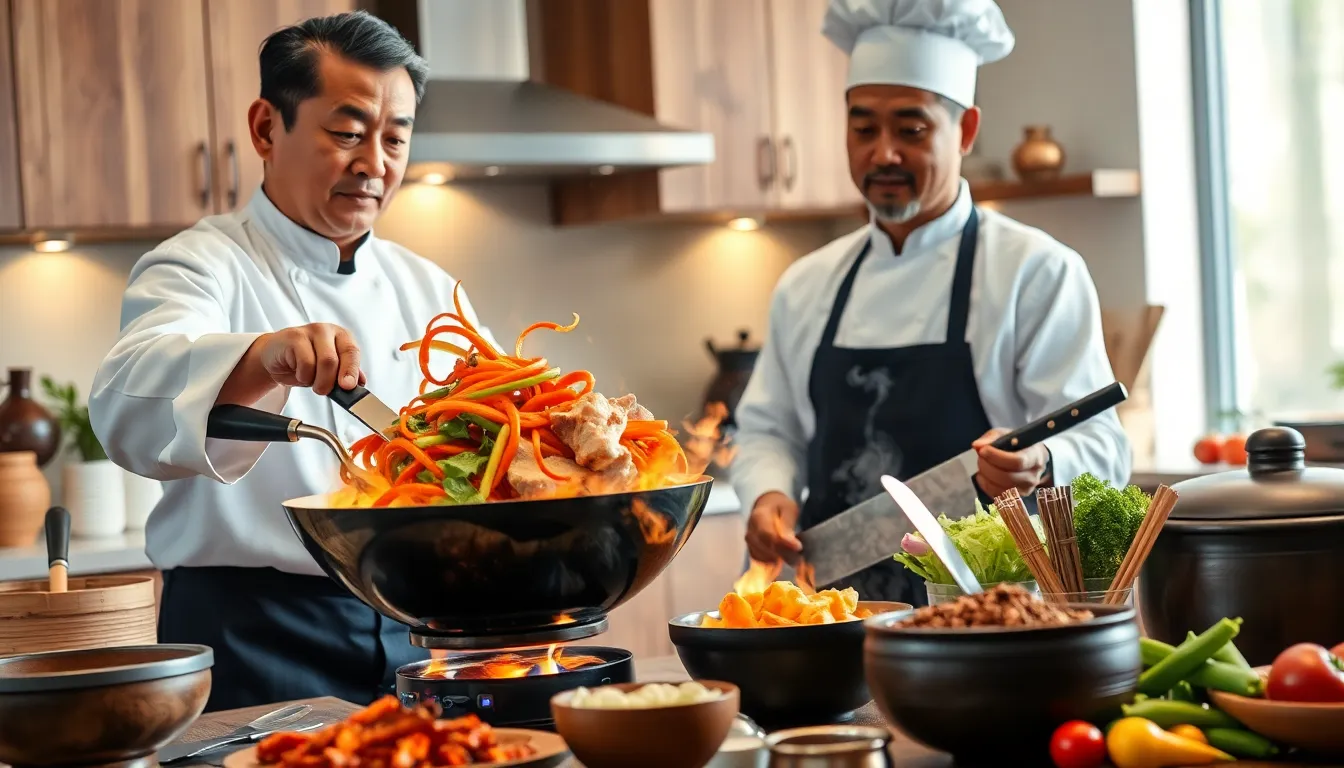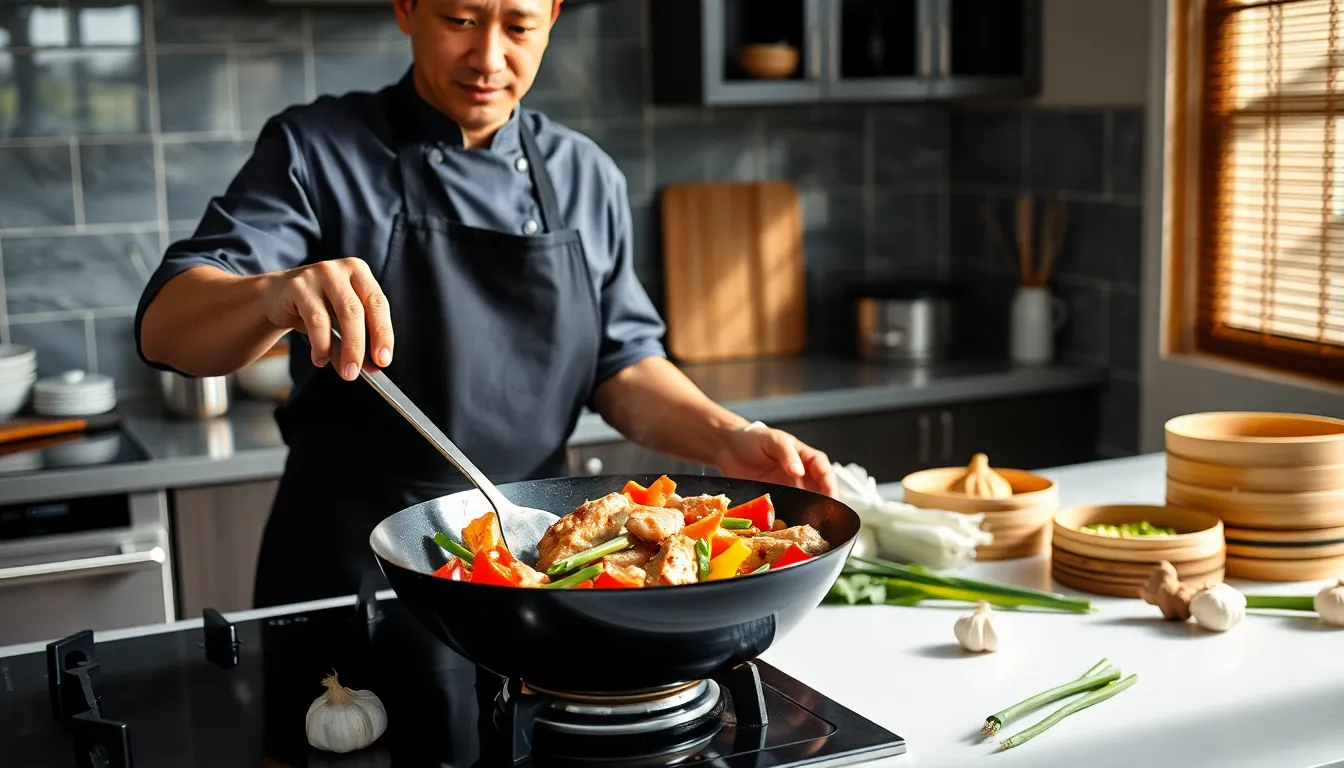If you’ve ever savored a plate of vibrant Kung Pao Chicken or delicate Dim Sum, you know there’s a magical touch behind Chinese cuisine. It’s not just about the ingredients: it’s the techniques that bring each dish to life. Ever thought about why your homemade fried rice doesn’t sparkle like takeout? It’s all in the technique. Whether it’s trying to replicate your favorite restaurant dish or simply impressing friends with your cooking prowess, understanding these essential Chinese cooking techniques is your golden ticket to flavor town. Let’s jump into the culinary world of China, where precision meets passion.
Table of Contents
ToggleOverview of Chinese Cuisine

Chinese cuisine is as diverse as its vast landscape, shaped by regional influences and historical factors. From the bold flavors of Sichuan to the subtle tastes of Cantonese, each culinary tradition boasts unique ingredients and styles. Has your mouth ever watered at the thought of a spicy hot pot bubbling away or the sweet aroma of Peking Duck wafting through the air? The beauty of Chinese cooking lies not only in its variety but also in its rich culinary heritage, which is crafted by techniques that have been perfected over centuries.
Importance of Cooking Techniques in Chinese Cuisine
Cooking techniques are the heart and soul of Chinese cuisine. While the right ingredients certainly matter, it’s the methods of preparation that determine whether a dish tastes authentic or just…meh. Techniques affect flavor, texture, and even nutritional value, making them essential for both home cooks and professional chefs. Understanding how to wield these methods transforms everyday meals into extraordinary culinary experiences.
Essential Chinese Cooking Techniques
Chinese cooking includes a variety of techniques, each bringing its own flair to dishes. Here’s a rundown of the essentials that every aspiring chef should master:
Stir-Frying
This technique is the fast track to tastiness. Using high heat and a small amount of oil, stir-frying seals in flavors while keeping ingredients crisp. Think of it as a cooking dance: quick, nimble, and high-energy.
Steaming
With roots in health-conscious cooking, steaming involves gently cooking food in vessels over simmering water. Steamed buns or fish come out tender and juicy, making it a preferred method, especially in southern regions. Nothing quite beats the simplicity and health benefits here.
Deep-Frying
Deliciously crisp on the outside yet tender on the inside, deep-frying elevates many dishes. Whether it’s crispy egg rolls or golden, crunchy fried rice balls, this technique uses piping hot oil to create that irresistible texture. Who can resist the crunch?
Braising
This slow-cooking method melds flavors beautifully. Braising involves searing proteins before simmering them in a flavorful liquid until tender. Picture tender, melt-in-your-mouth beef shank simmered with aromatic spices, a true comfort food winner.
Roasting
Used often for meats, roasting imparts a deep flavor while rendering fat, leading to deliciously crispy skin. Take Peking Duck, a culinary masterpiece that showcases the art of roasting to perfection.
Sautéing
Sautéing might just be stir-frying’s more relaxed cousin. It requires medium heat and a bit more oil, allowing for wonderful caramelization without the frantic pace of stir-frying. Toss in some veggies and meat for a colorful, tasty mix.
Culinary Tools and Equipment
Having the right tools at your disposal is crucial while navigating the world of Chinese cooking. Here are some staples to consider:
Wok: The Versatile Cooking Vessel
A wok is essential for many of the techniques mentioned, especially stir-frying and steaming. Its shape allows food to cook evenly and quickly, and let’s face it, nothing screams ‘authentic’ more than a well-seasoned wok on your stovetop.
Cleavers and Knives
Chinese cleavers and knives are designed with precision, making chopping and slicing a breeze. The wide blade is perfect for crushing garlic, while the sharp edge tackles any meat or vegetable with ease. They aren’t just tools: they’re an extension of your culinary capabilities.
Steamers and Baskets
When it comes to steaming, bamboo steamers are the go-to. These allow for even cooking while imparting a subtle earthy flavor to the food. Also, they stack easily, making them a wise choice for any kitchen.
Cultural Significance of Techniques
The techniques of Chinese cooking vary greatly across different regions, influenced not only by local ingredients but also by historical and cultural contexts. In northern China, the emphasis on wheat-based dishes contrasts sharply with the rice-centric fare of the south. Each cooking method tells a story, reflecting the beliefs and traditions of its people, whether it’s the scoop of rice as a staple or the lavish banquets of celebration.
Influence on Contemporary Cuisine
Today, the impact of Chinese cooking techniques can be seen far beyond their own borders. Globally, they inspire an array of fusion cuisines that combine Western practices with traditional Chinese methods. Think of crispy wontons filled with mozzarella or stir-fried noodles seasoned with Italian herbs. Such culinary crossovers not only highlight adaptability but also emphasize how deeply rooted techniques can evolve while still honoring their origins.





